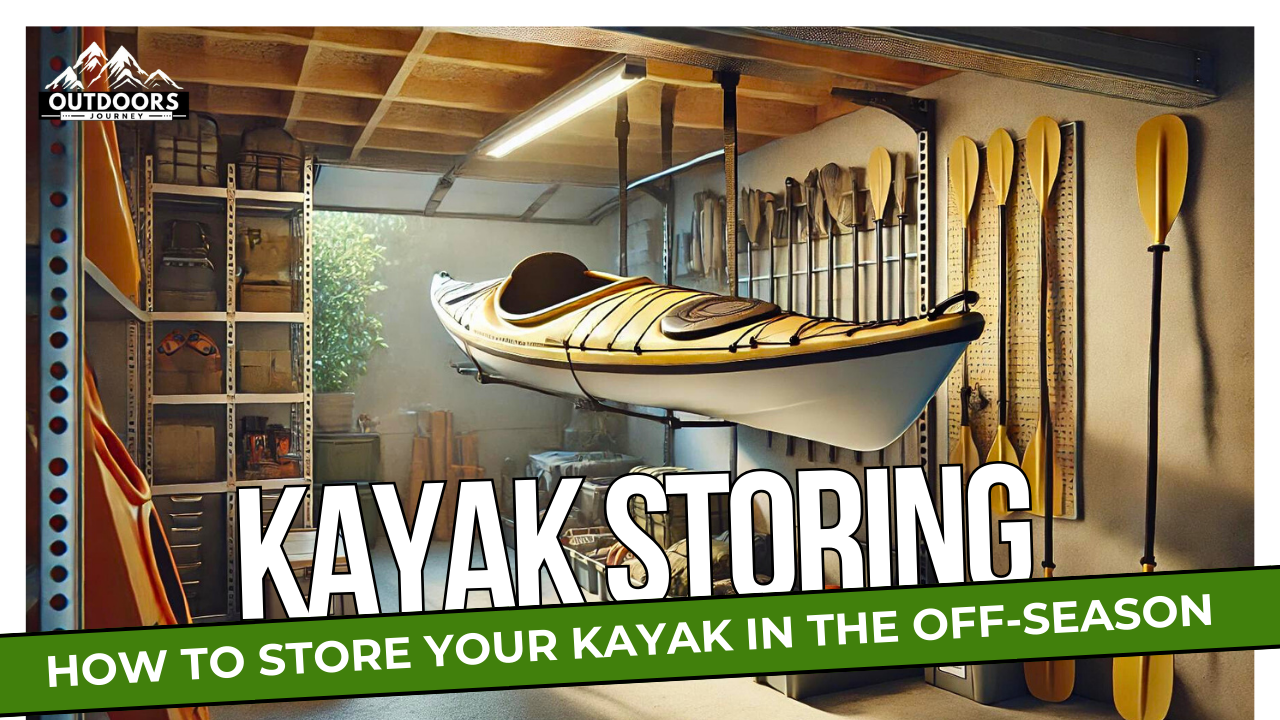Did you know storing your kayak right can make it last longer? If you don’t store it well, things like rain, snow, and sun can harm it. This can cause damage like warping, fading, and even making it distort. So, having a good plan for storing your kayak in the off-season is key.
It doesn’t matter if you use it a lot or just for short times. Knowing how to take care of your kayak in the off-season keeps it ready for when you want to use it again.
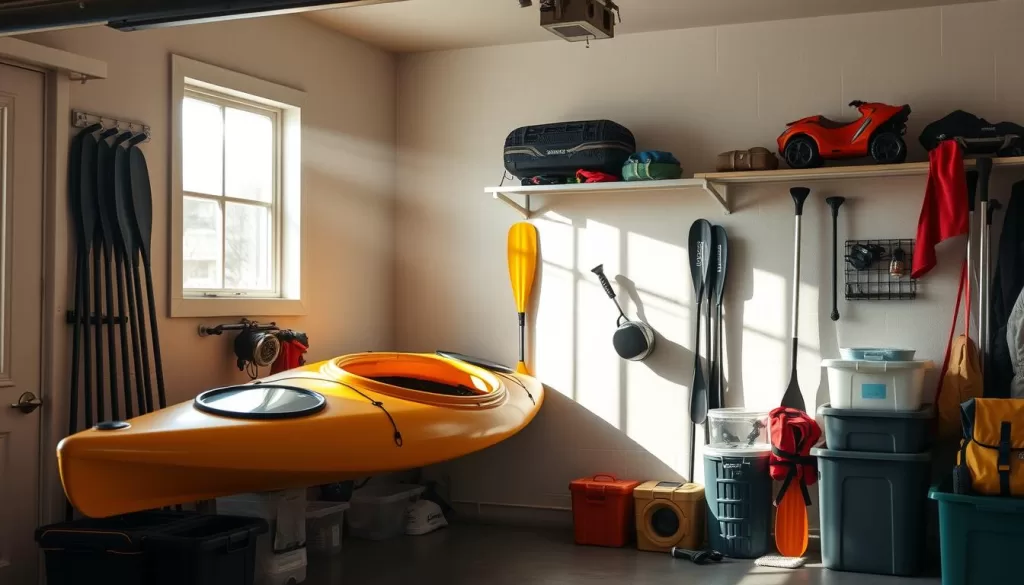
Keeping your kayak in good shape off-season isn’t just about cleaning it. It’s also about stopping damage, keeping it strong, and keeping it safe from theft. By storing it right, you protect your investment and make sure it’s ready for your next adventure on the water. Let’s look at how to store your kayak off-season the right way.
Key Takeaways
- Storing your kayak properly protects it from the weather and makes it last longer.
- Indoor storage is best to avoid damage from UV rays and moisture.
- Use covers for outdoor storage to protect your kayak from the elements.
- Cleaning and maintaining your kayak regularly in the off-season is crucial for its health.
- Plan for both short-term and long-term storage based on how much you use it.
- Make sure your kayak is stored safely to prevent theft and damage.
- Think about using UV protectants to keep your kayak from fading.
- 1 Importance of Proper Kayak Storage
- 2 Preparing Your Kayak for Storage
- 3 How to Store Your Kayak Indoors
- 4 How to Store Your Kayak Outdoors
- 5 Store Kayak Off Season: Tips and Best Practices
- 6 Short-Term Kayak Storage Tips
- 7 Long-Term Kayak Storage Tips
- 8 Impact of Weather on Kayak Storage
- 9 Storage Solutions for Different Types of Kayaks
- 10 Common Mistakes in Kayak Storage
- 11 Using Storage Racks and Suspension Systems
- 12 Storage Facilities and Rentals for Your Kayak
- 13 FAQ
- 14 Source Links
Importance of Proper Kayak Storage
Properly storing your kayak in the off-season is key to its longevity and performance. If not stored right, your kayak can face weather damage and warping. Knowing how to store it right keeps your kayak in great shape for many seasons.
Protecting from Elements
Your kayak can be hurt by rain, snow, and UV rays. These elements can fade colors and weaken materials. Use covers or keep it in the shade to protect it from the sun. Also, a tarp tent can stop moisture from building up when storing it outside.
Preventing Damage and Deformation
How you store your kayak can stop it from getting deformed or stressed. Rotate it regularly against a wall to spread the weight evenly. This reduces damage risk. Don’t keep it on flat surfaces for too long, as it might get crushed. Use a 10×10 storage unit or bigger to keep your kayak in a steady temperature and humidity.
| Storage Technique | Benefits | Potential Issues |
|---|---|---|
| Indoor Storage Units | Consistent temperature and humidity control | Limited space if not planned correctly |
| Using Covers | Protection from UV rays and precipitation | Potential for mold if not ventilated |
| Weight Distribution | Prevents warping and damage from pressure points | Requires regular attention to storage position |
| Outdoor Tarp Setup | Minimizes moisture build-up | Requires stability to withstand winds |
Using the right storage methods for your kayak avoids expensive fixes. It keeps your kayak performing well and looking good.
Preparing Your Kayak for Storage

Getting your kayak ready for storage is key to keeping it in good shape. It involves cleaning it first and checking for damage before you store it away. These steps are crucial for your kayak’s long life.
Cleaning Your Kayak
Start by cleaning your kayak with a mild detergent and lukewarm water. This gets rid of dirt, salt, and moisture that can harm it. Make sure to clean all surfaces well.
After cleaning, rinse and dry the kayak thoroughly. Remove all accessories like seats and dry boxes. This helps prevent moisture and dirt from getting trapped.
Inspecting for Damage
Checking for damage is just as important. Look at the hull, hatches, and accessories for cracks, scratches, or wear. Fixing minor damage early can prevent bigger problems later.
Focus on moving parts and areas prone to stress. Replace any broken parts before storing your kayak. This keeps it safe during the off-season.
Consider putting your kayak on a stand and covering it with a winter cover. Doing this keeps it in great shape for many years.
How to Store Your Kayak Indoors
Storing your kayak indoors is key to keeping it safe from damage. The right storage spot helps keep your kayak in good shape for longer. Garages, sheds, or basements are great places to store your kayak safely.
Ideal Indoor Storage Locations
Think about these spots for storing your kayak:
- Garages: They offer lots of space and keep your kayak safe from extreme weather.
- Sheds: Perfect if you don’t have a garage, they provide a stable environment.
- Basements: Ideal for controlling the climate and managing moisture, keeping your kayak away from the elements.
Temperature Control and Moisture Management
Keeping the right temperature and managing moisture is crucial for storing kayaks indoors. Look for a spot that controls the climate and keeps moisture in check. Too much humidity can cause mold, which is bad for kayaks. Don’t put your kayak near heaters or areas with big temperature changes, as it can damage the material.
Here are some tips for better indoor storage:
- Keep kayaks off the ground to stop moisture from building up.
- Think about hanging your kayak with strong supports and straps to keep its shape and prevent warping.
- Follow the 30 percent rule when supporting kayaks to avoid dents or damage.
Following these tips will keep your kayak in great shape for your next trip. Storing it in a garage with good climate control is a smart move. It protects your kayak from the bad effects of weather.
How to Store Your Kayak Outdoors
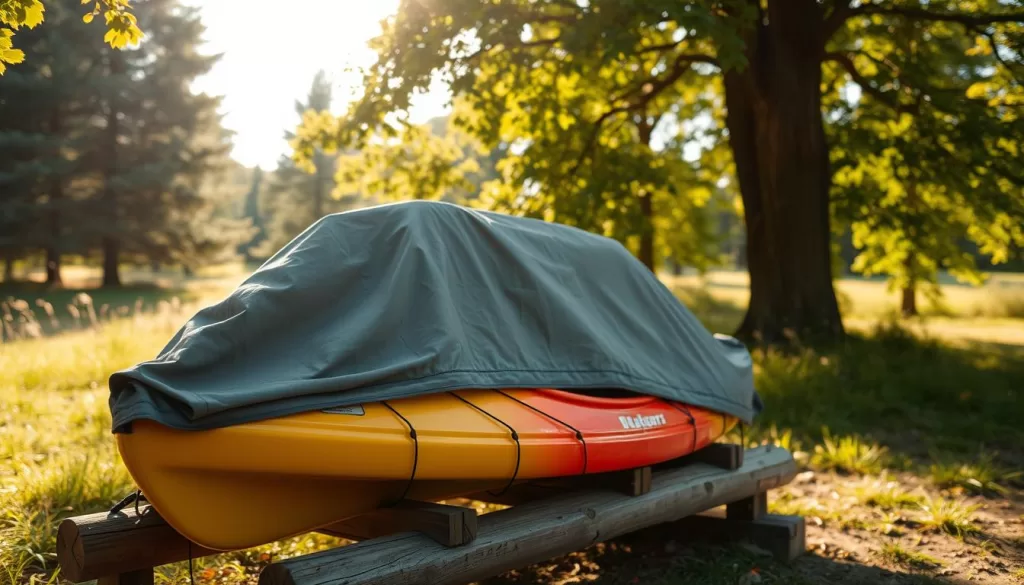
Storing your kayak outdoors needs careful thought to avoid damage from the elements. Picking the right spot is crucial for keeping your kayak in good shape. Use protective covers to keep your kayak safe from harsh weather.
Choosing the Right Outdoor Location
Choosing the best spot for your kayak is key. Find shaded spots like under a covered porch or shed to cut down on sun damage. Kayaks left outside in Mississippi for four years stayed in great condition, showing that the right spot can help. Don’t put your kayak on the ground to avoid moisture issues. Keep it deck-side down to let water drain out and prevent buildup inside.
Using Covers for Protection
A kayak cover is essential for keeping your kayak safe. A good, waterproof cover protects against rain, snow, and UV rays. In places like Arizona, where the sun is strong, using a tarp is a must to prevent damage. Check and replace the tarp often to avoid damage from too much sun. Use cockpit covers for sit-inside kayaks to block moisture, dust, and wildlife. Adding marine wax to the deck gives extra UV protection and keeps it shiny while stored outside.
| Storage Method | Effectiveness | Notes |
|---|---|---|
| Shaded Areas | High | Reduces sun and precipitation exposure. |
| Deck-side Down Position | Medium | Prevents moisture accumulation. |
| Waterproof Covers | High | Protects against rain and UV rays. |
| Regular Tarp Replacement | High | Essential due to UV damage over time. |
By following these tips for outdoor storage and using protective gear, you can make your kayak last longer. This way, you can enjoy more seasons on the water.
Store Kayak Off Season: Tips and Best Practices
Storing your kayak right during the off-season keeps it in good shape and makes it last longer. Many people forget this, which can cause damage. By following some best practices, you can keep your kayak and paddles ready for the next time you go paddling.
Methods for Proper Support
Using the right support when storing your kayak helps keep its shape and stops it from getting deformed. Here are some tips:
- Use padded supports to cushion the kayak.
- Don’t let the kayak touch the ground to avoid moisture damage.
- Keep your kayak off the ground, about 30% from the ends, to stop it from warping.
Preventing Mold and Moisture Build-Up
Keeping moisture away is key when storing your kayak in the off-season. Here’s how to stop mold and moisture from building up:
- Clean your kayak well before storing it to get rid of any residue or organic stuff.
- Make sure your kayak is dry before you store it to prevent dampness.
- Check for moisture often during the off-season to find problems early.
UV Protection Techniques
UV rays can fade and damage your kayak over time. Here are ways to protect it from UV rays:
- Use a UV shield like wax or a special spray to protect the material.
- Put a protective cover on your kayak when it’s outside to block UV rays and bad weather.
- Think about storing your kayak in a place with controlled climate to reduce damage from the elements.
By following these tips for storing your kayak, you’ll make it more durable. You’ll also make it easier to start paddling again when the season comes back.
Short-Term Kayak Storage Tips
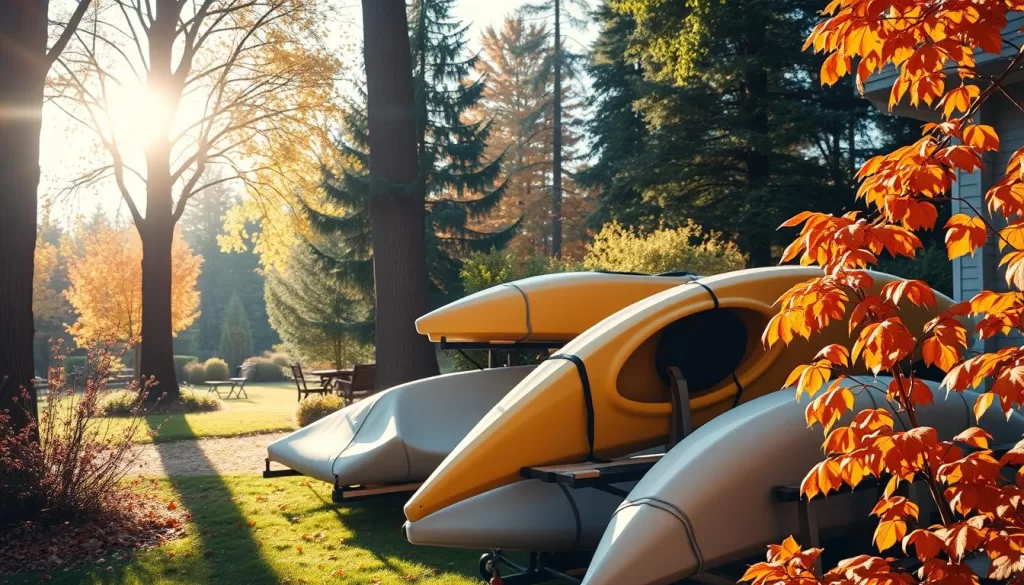
When you’re not using your kayak for a few days or weeks, short-term storage is a good choice. It’s great for brief vacations or when the weather isn’t right for kayaking. Think about where you place your kayak to make it easy to get to and keep it safe.
When to Use Short-Term Storage
Use short-term storage for short periods when you’re not using your kayak. It keeps your kayak safe without the need for long-term storage. Here are some situations where this is useful:
- Weekend getaways
- Unpredictable weather conditions
- Short breaks between kayaking trips
Accessibility and Security Considerations
Make sure your kayak is easy to get to when using short-term storage. A secure spot means you can quickly grab it when you want to go kayaking. Here are some tips for good storage:
- Lockable storage units offer enhanced theft prevention.
- Vertical positioning against a wall can save space while keeping your kayak secure.
- Utilize a garage or a covered area that provides protection from the elements.
Keep these points in mind to store your kayak safely and make it ready for use anytime. Focus on easy access and security to protect your kayak and keep it in great shape.
| Storage Option | Accessibility | Theft Prevention |
|---|---|---|
| Lockable Storage Unit | High | Very High |
| Garage | Moderate | Moderate |
| Covered Outdoor Area | High | Low |
Long-Term Kayak Storage Tips
When storing your kayak for a long time, especially in winter, finding enough space is key. A good storage spot keeps your kayak safe from the cold and wet weather. It’s important to keep your kayak in a place that stays dry and doesn’t change temperature a lot.
Finding Adequate Space
Think about these tips for storing your kayak for a long time:
- Look for a dry, indoor spot like a garage or shed.
- Make sure the area is free from pests that might be drawn to things like minicell foam.
- Choose a place that doesn’t get a lot of sunlight, as it can harm your kayak.
Necessary Preparations for Long-Term Storage
Getting your kayak ready for long-term storage is crucial. Here’s what you should do:
- Clean your kayak well after each use to stop mold and dirt from building up.
- Check for any damage and fix it before you store your kayak.
- Store your kayak upside down or on its side to stop it from warping.
- If needed, use a UV protectant like Scotch 303 to keep the sun from damaging it.
Planning ahead for when you’ll use your kayak again makes getting it ready easier. These steps not only make your kayak last longer but also make it more fun to use. Proper storage in winter means planning and taking good care of your kayak. This makes a big difference in your future kayaking trips.
Impact of Weather on Kayak Storage
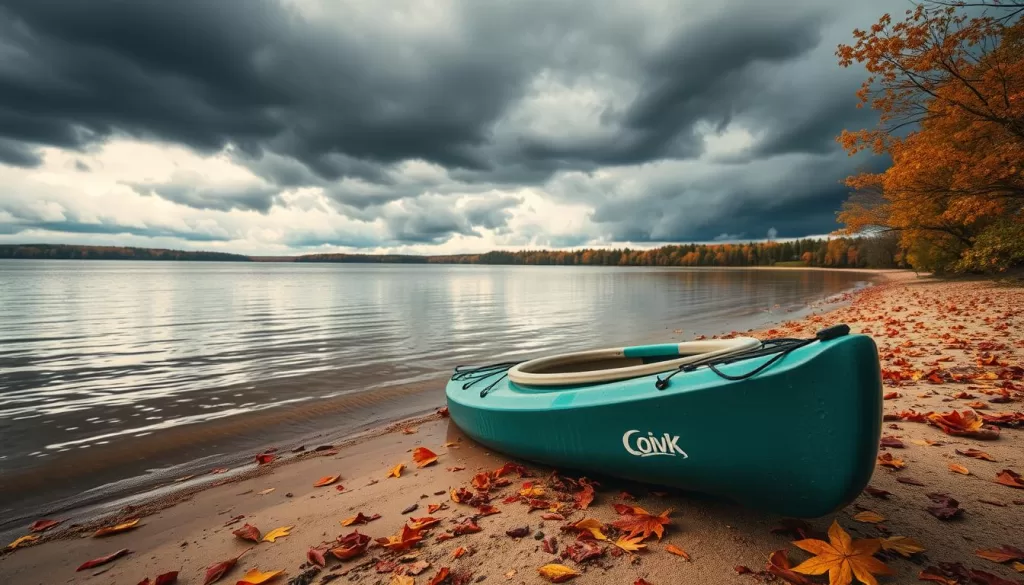
Weather greatly affects how long your kayak lasts. Knowing how different weather conditions impact your kayak can make it safer and last longer. This part talks about how UV damage and temperature extremes can affect your kayak.
Effects of UV Damage
UV rays can harm your kayak, especially the hull. They cause it to fade and get weaker. To fight this, use protective covers and keep kayaks in the shade when not in use.
If you must store your kayak outside, get a good cover that blocks the sun’s harmful rays.
Handling Extreme Temperatures
Extreme temperatures are tough on kayaks. In very cold, they can get brittle. In hot weather, they might warp.
To protect your kayaks, use padding and foam under the hull and on storage hooks. Store them on their sides or upside down to keep them safe. Insulating garage doors and drying kayaks before storage also helps them handle the weather better.
Storage Solutions for Different Types of Kayaks
Storing your kayak right depends on its type. Each design needs its own way to stay in good shape. You should think about how to store inflatable and rigid kayaks, like sit-in and sit-on-top ones.
Storing Inflatable Kayaks
Inflatable kayaks are easy to store because you can fold them up. Keep them in a dry place with little humidity to stop mold. A climate-controlled environment, like a basement, is best.
Use strong bags made of nylon and polyester for storage. This keeps them safe from damage.
Considerations for Sit-In and Sit-On-Top Kayaks
For sit-in kayaks, how you store them matters a lot. Try to keep them inside to protect them from the sun and harsh weather. Use racks on walls or freestanding units to keep them off the ground.
This keeps them safe from moisture and pests. Make sure they’re stored evenly to prevent damage to the hull. If you’re storing them outside, use covers that block UV rays and secure them to stop theft.
Common Mistakes in Kayak Storage
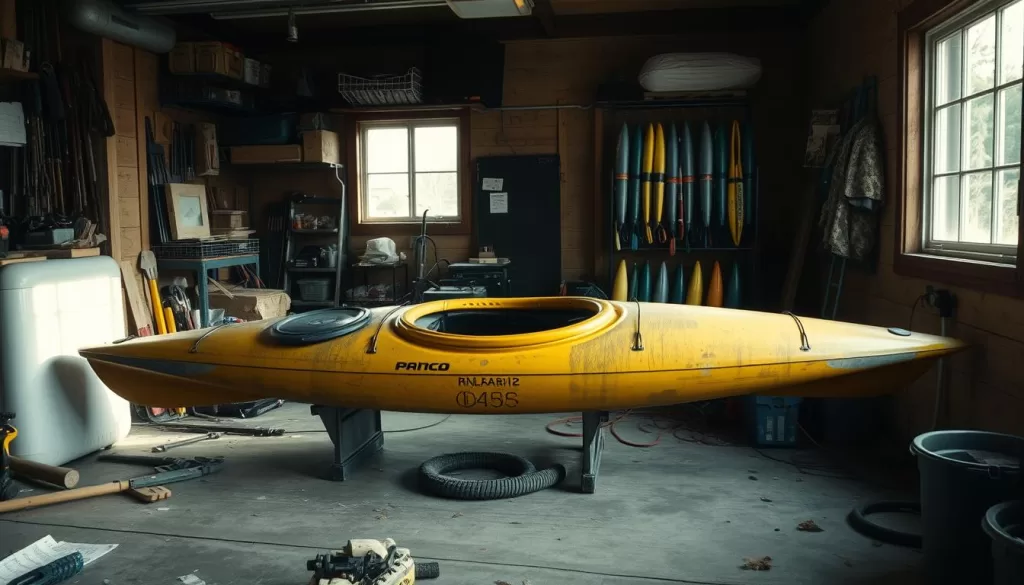
Storing your kayak right is key to keeping it in top shape. Avoiding common errors can prevent costly repairs and improve your time on the water. Many kayakers skip important cleaning and support steps, leading to big problems.
Not Cleaning Properly
Many kayakers forget to clean their kayaks well before putting them away. Leaving dirt or moisture on the kayak can cause big problems, like mold or damage to the materials. Cleaning your kayak properly, by rinsing off salt water and drying it, is crucial to protect your investment. A clean kayak is a happy kayak.
Storing Kayaks on the Ground
Storing kayaks on the ground is another big mistake. It leads to moisture buildup, which can harm your kayak. Using a simple support system can really help protect your kayak. Think about using shelves, racks, or hoisting systems to keep your kayak off the ground. This keeps the hull safe, avoids damage, and keeps your kayak in great shape.
Using Storage Racks and Suspension Systems
Storing your kayak right is key to keeping it in top shape. Using storage racks and suspension systems is a great way to protect your kayak and save space. By going vertical, you free up room and lower the risk of damage, making it easy to get your kayak when you need it.
Benefits of Vertical Storage
Vertical storage saves floor space and shields your kayak from harm. Keeping your kayak upright stops it from getting deformed. It also keeps it dry and safe from pests, cutting down on mold and other damage. Plus, it’s easier to grab your kayak for your next trip.
Choosing the Right Storage System
Choosing the right storage system depends on your space and the type of kayak you have. Here are some options:
- Wall-attached racks: Perfect for those with little floor space, like the Minimalist Paddle Board Wall Rack.
- Freestanding racks: A flexible choice, such as the RAD Sportz Freestanding Storage Rack.
- Ceiling racks: Use overhead space with systems like the StoreYourBoard 2 Kayak Ceiling Storage Rack.
- Suspended storage systems: A budget-friendly option that fits many kayaks, like the Pelican Store Double Kayak Storage System.
Think about your kayak’s size and weight when picking a storage option. Putting your kayak up or on a rack keeps it safe and sound, no matter the weather. Here’s a look at some common storage choices:
| Storage Type | Advantages | Considerations |
|---|---|---|
| Wall Attached Rack | Space-saving, easy access | Needs tools for installation, and can be tricky |
| Freestanding Rack | Portable, versatile | Needs wall space, and might not hold big kayaks |
| Ceiling Rack | Uses vertical space well | Needs tools for installation, can be tricky |
| Suspended System | Good for storing many kayaks | May need extra support for heavy items |
Storage Facilities and Rentals for Your Kayak
If you’re running out of space at home for your kayak, consider storage facilities or rentals. Climate-controlled units are great because they keep a steady temperature and humidity. This protects your kayak from the weather and keeps it safe.
Severe weather can harm kayaks, but these units help avoid that. They make your kayak last longer and keep it in top shape.
Advantages of Climate-Controlled Storage
Choosing a climate-controlled unit is a smart move for your kayak. It lowers the risk of damage from UV rays, a big worry for kayakers. Plus, if the place has drive-up access, it’s easier to get your kayak in and out.
This makes getting ready for boating season a snap, even with big kayaks or more than one.
Access and Security Features to Consider
Think about the security and how you can get to your kayak when picking a storage spot. Look for places with cameras, gates, and other safety features. This keeps your kayak safe from theft or harm.
With different ways to get in, you can rest easy knowing your kayak is secure and ready for your next adventure. Choosing these options means your kayak and your storage spot are both safe.
FAQ
How should I clean my kayak before storing it?
What are the best indoor storage options for my kayak?
Can I store my kayak outside? If so, how can I protect it?
What is the proper way to store my kayak to prevent warping?
How can I ensure my kayak is safe during short-term storage?
What preparations should I make for long-term kayak storage?
How do weather conditions affect kayak storage?
What should I do if I have an inflatable kayak?
What are common mistakes to avoid while storing my kayak?
How can storage racks and suspension systems benefit my kayak?
What are the advantages of using a climate-controlled storage facility?
Source Links
- How to Store a Kayak | Kayak Storage | EZ Dock – https://www.ez-dock.com/blog/how-to-properly-store-your-kayak/
- How to Maintain Your Kayak in the Off-Season – https://brooklynkayakcompany.com/blogs/our-blog-2/how-to-maintain-your-kayak-in-the-off-season?srsltid=AfmBOoptaaKMJmWBLqHZ9x5zu0BkjIdEJK4vRJYVIV85Yiu7fjRhQ6Yd
- How to Store a Kayak Without Damaging the Hull – https://www.lifestorage.com/blog/storage/how-to-store-a-kayak/
- How to Properly Store a Kayak Outdoors – Haven Dock & Marine – https://havendock.com/blogs/tips/how-to-properly-store-a-kayak-outdoors?srsltid=AfmBOoqIeyDNBiELhbWtNxbINJ-DZ1vgiJMNLI_TSFvyIjONWHwvNM9Z
- How to Store Your Kayak in the Winter: 5 Tips to Prevent Damage – https://www.outdoorplay.com/blogs/news/how-to-store-kayak-during-winter?srsltid=AfmBOooUgJk8JTfolClE4KGYT54aLwxvLBl8iqJY0tmqQuoST_wE_ieR
- How to Maintain Your Kayak in the Off-Season – https://brooklynkayakcompany.com/blogs/our-blog-2/how-to-maintain-your-kayak-in-the-off-season?srsltid=AfmBOop9GzG-67aMBXXTpuQswAySCNRVACWSGulNVEXIS4_RiqOa-0yx
- How to Store a Kayak in Winter – https://outdoors.com/how-to-store-kayak-in-winter/
- Kayak Storage…AGAIN. – https://forums.paddling.com/t/kayak-storage-again/21862
- How To Store A Kayak Properly (Indoors, Garage, or Outside) – https://www.outdoorplay.com/blogs/news/how-to-store-a-kayak?srsltid=AfmBOootAL4iBD0Yb-k00FjQ9V1Ai-zKaMmhJdke5x0KQecYnJxFy-gX
- storing kayaks outside? – https://forums.paddling.com/t/storing-kayaks-outside/62265
- How to Properly Store a Kayak – https://www.gilisports.com/blogs/kayaking/how-to-properly-store-a-kayak?srsltid=AfmBOorYS8XUBpioPc03PqbOASfDdeACnY5K5X45JfDdcCY1QabHD957
- Best Practices on How to Store a Kayak – TMS Self Storage – https://tmsselfstorage.com/best-practices-on-how-to-store-a-kayak/
- 5 Easy Kayak Storage Tips to Keep Your Kayak Damage-Free – https://www.storespace.com/tips-advice/storage/tips/kayak-storage-tips
- How to Properly Store a Kayak | SROA Blog Store a Kayak – https://www.sroa.com/blog/storage-tips/how-to-properly-store-a-kayak
- How to Store Kayaks – A Guide on Kayak Storage Ideas – https://www.wired2fish.com/kayak-fishing/how-to-store-kayaks-a-guide-on-kayak-storage-ideas
- Cold Weather Kayak Storage – https://forums.paddling.com/t/cold-weather-kayak-storage/67003
- Lifetime Blog: Winter Kayak Storage Tips – https://www.lifetime.com/blog/post/winter-kayak-storage-tips
- Winter kayak storage in the Midwest – Tips? – https://forums.paddling.com/t/winter-kayak-storage-in-the-midwest-tips/103471
- How to Store Your Kayak in the Winter: 5 Tips to Prevent Damage – https://www.outdoorplay.com/blogs/news/how-to-store-kayak-during-winter?srsltid=AfmBOorto5GsJSMx_qcJjnRPl-HM6GdxFdPOdHlZRMHl9GQ3uFm4GQNK
- Guide to Kayak Storage: Keeping Your Boats Organized Year-Round – https://storeyourboard.com/blogs/ideas-advice/guide-to-kayak-storage-keeping-your-boats-organized-year-round?srsltid=AfmBOorxosOa1KguihQaxXW7N8Ta6GDevfZbqTYr1ebLj8zImtSOod3h
- The Ultimate Guide to Kayak Storage for Inflatables and Hardshells – https://www.outdoorplay.com/blogs/news/the-ultimate-guide-to-kayak-storage-for-inflatables-and-hardshells?srsltid=AfmBOorsNVlGw5SQd29zCwRhTzB3nSw_9p1_CqI47c6REHCPrGtm5Ee0
- Store a Kayak: Essential Tips for Safe and Smart Storage Solutions – https://www.lake.com/articles/store-a-kayak/
- Storing a kayak? – https://forums.paddling.com/t/storing-a-kayak/16677
- How To Store A Kayak Properly (Indoors, Garage, or Outside) – https://www.outdoorplay.com/blogs/news/how-to-store-a-kayak?srsltid=AfmBOooli6upAUDm68A2LbXd0hM0WIokdnIYUOuUpXQy01nNqXV6ubwT
- How to Properly Store a Kayak – https://www.gilisports.com/blogs/kayaking/how-to-properly-store-a-kayak?srsltid=AfmBOopwDufBt4aora-yUDgoUrbBjsMuIIrIHANIlP7LQMGKaDTALpRq
- How To Store A Kayak Indoors Or Outdoors & Keep It In Top Shape Year-Round – https://www.watersportswhiz.com/how-to-store-a-kayak/
- Apartment Living. Where to store Kayak? – https://forums.paddling.com/t/apartment-living-where-to-store-kayak/27556
- Owning a canoe while living in a city, apartment, condo or high-rise – https://www.canoetripping.net/threads/owning-a-canoe-while-living-in-a-city-apartment-condo-or-high-rise.127457/
